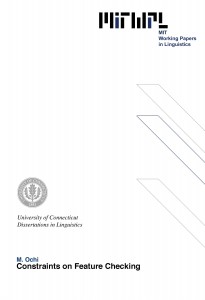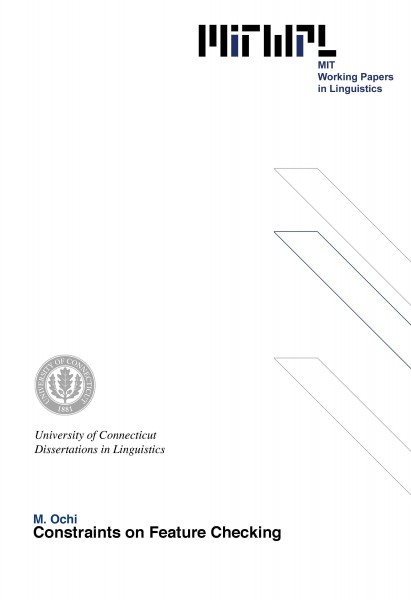Constraints on Feature Checking
M. Ochi, 1999
ABSTRACT
Recent development in the principles and Parameters approach to linguistic theory, known as the Minimalist program (Chomsky 1993, 1995), attributes the displacement property of languages to the need to check off (a subset of) formal features. The aim of this thesis is to explore some consequences of this feature-based conception of movement
Chapter 2 is concerned with locality issues arising from Attract F. The Attract (i.e., target-based) view of movement offers a simple account of certain island effects, in particular, Relativized Minimality (RM) (see Rizzi 1990) type islands. However, non-RM type islands constitute an insurmountable obstacle for Attract. Building on Chomsky's (1995: chapter 4) idea that overt movement involves (at least) two chains, the formal feature chain and the (generalized) pied-piping chain, I provide an analysis which solves empirical problems of Attract, while providing further arguments for the Attract view of movement
Chapter 3 focuses on the nominative/genitive Case conversion phenomenon in Japanese. Based on Miyagawa's (1993) insightful analysis of this construction, I argue that this construction and the Exceptional Case Marking (ECM) construction in English, especially as analyzed by Lasnik (1998), show remarkable parallelism and hence should be given a unified account. I also argue that the Attract view of movement explored in chapter 2 provides a simple account of the locality effects observed with the movement of genitive phrases in Japanese.
Chapter 4 explores the nature of strong features by studying the type of wh-questions originally investigated by Muratori (1996a, b, 1997). The 'virus' theory of feature strength (Chomsky 1995: chapter 4) virtually forces a strong feature to be a property of the target, not of the moving item. However, nothing in the logic behind the concept of the strong feature precludes the possibility that it is a property of the moving item. I propose that there are in fact some adjunct wh-phrases which are best analyzed as having strong features which need to be chocked off against the interrogative complementizer. This analysis accounts for some peculiar properties of those adjunct wh-phrases in a simple manner.
TABLE OF CONTENTS
Chapter 1: Introduction Minimalism and
the displacement property of languages 1
1.2 Outline of the thesis 5
Chapter 2: Two Chain Hypothesis and Its Consequences
2.1 Introduction 6
2.2 Minimalist approaches movement and locality 7
2.2.1 Move and minimality 10
2.2.2 Takahashi (1994) 10
2.2.3 Chomsky (1995): Attract F 17
2.3 Attract F and minimality 20
2.3.l Setting the stage 20
2.3.2 Brief overview 21
2.4 Two chain hypothesis 23
2.4.1 Wh-island affects 28
2.4.2 CED effects 30
2.4.3 Complex NP constraint effects 34
2.4.4 More on wh-in-situ 36
2.4.5 Summary 43
2.5 Derivational constraint on movement 44
2.5.1 Acyclic merger 44
2.5.2 Adjunction and chain uniformity 48
2.6 Further consequences 50
2.6.1 Binding conditions and the content of formal features 50
2.6.2 Feature movement and coordinate structures 55
2.7 Remaining issues 60
2.8 Conclusion 63
Appendix 1: More on adjunct condition effects 64
A.1.1 Obligatory acyclic insertion of adjuncts 65
A.1.2 Multiple spe1l-out and island effects 68
A.l.3 Adjuncts and extraposition 72
Appendix 2: more on acyclic insertion 75
Chapter 3: Optionality in the Timing of A-movement
3.1 Introduction 84
3.2 Case conversion in Japanese and the edge puzzle 86
3.2.1 LF Case checking: Miyagawa (1993) 87
3.2.2 Questions 91
3.2.2.1 Some edge puzzles 91
3.2.2.2 Formal features and pied-piping 95
3.3 Optionality in the timing of genitive phrase movement 97
3.3.1 Proposal 97
3.3.2 The edge puzzle revisited 97
3.3.3 Formal features and pied-piping revisited 99
3.4 A-movement and the timing of movement 99
3.4.1 Exceptional case marking marking and optionally
overt raising: Lasnik (1998) 100
3.4.2 On the nature of genitive subject raising 102
3.4.3 Optionality and the Minimalist Program 108
3.5 Nominative/genitive object and the optionality of AGRo 111
3.5.1 On genitive object 112
3.5.2 On nominative object 115
3.5.3 Ga/no conversion and superiority 117
3.5.4 Alternative approach 123
3.6 Raising vs. control 128
3.7 Attract F and locality conditions 138
3.8 Ga/no conversion and NP-deletion 144
3.9 Conclusion 151
Chapter 4: The Syntax of Adjunct Wh-NPs and Feature Strength
4.1 Introduction 152
4.2 On Adjunct Wh-NPs 152
4.3 Adjunct Wh-NPs in wh-in-situ languages 157
4.3.1 Adjunct wh-NPs in wh-in-situ languages as VP-level adjuncts 157
4.3.2 Remarks on Kurafujis (1997) analysis 163
4.4 Wh-in-situ languages vs. wh-fronting languages 171
4.4.1 Locality 171
4.4.2 Multiple wh-questions 173
4.5 How come and why (Collins 1991) 176
4.6 Feature strength and the virus theory 181
4.7 Consequences 185
4.7.1 How come revisited 185
4.7.2 Inner island effects 187
4.7.3 More adjunct wh-phrases with a strong wh-feature 189
4.7.4 Argument vs. adjunct asymmetry 195
4.7.5 Another nani what –question 199
4.8 Remaining puzzles 206
4.8.1 Feature strength and cross-linguistic variations 206
4.8.2 Sluicing puzzles 207
4.8.3 Adjunct tags 208
4.9 Concluding remarks 210
References

